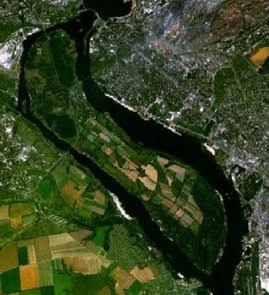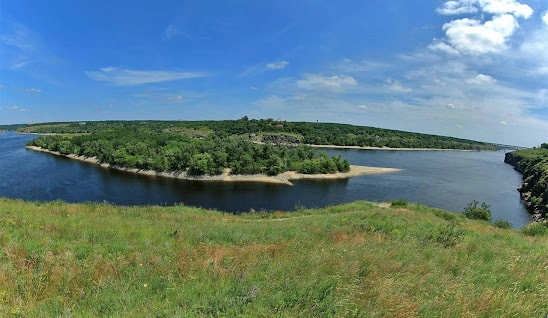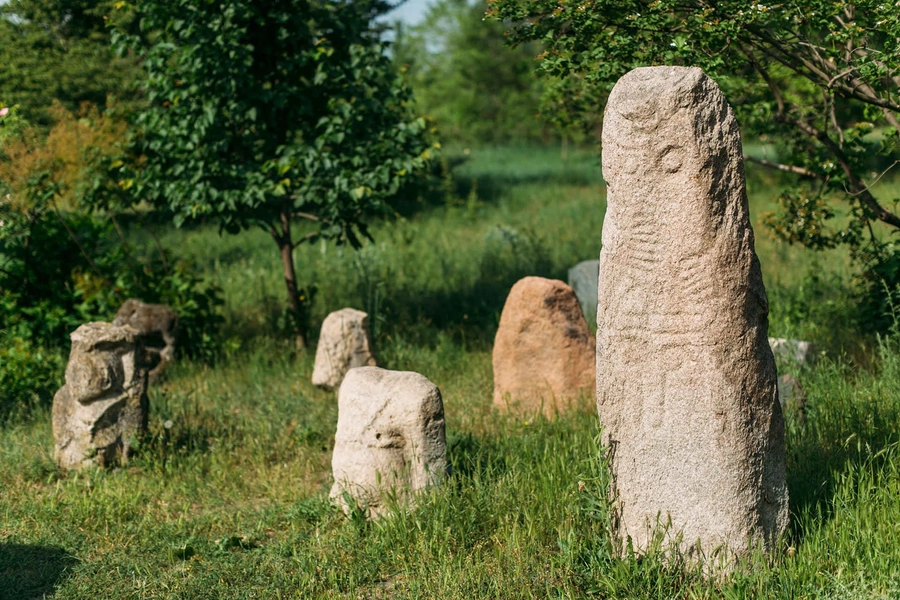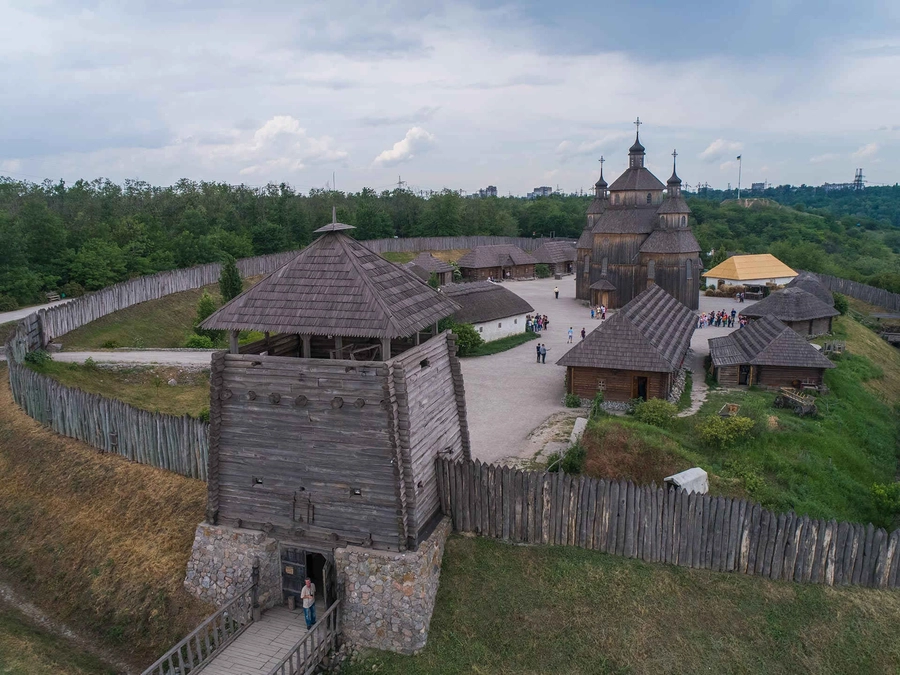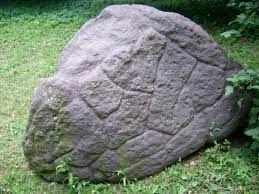Khortytsia, the largest island on the Dnipro and the largest river island in Europe, is part of the big industrial city of Zaporizhzhia, just south of the Dnipro Hydropower Station – one of the biggest in Ukraine and Europe. Owing to its unique landscapes, wildlife and its great historical value, Khortytsia was chosen in a national competition as one of “Seven Wonders of Ukraine.”
JOIN US ON TELEGRAM
Follow our coverage of the war on the @Kyivpost_official.
Satellite image of Khortytsia island
The island stretches eight miles from northwest to southeast and is almost two miles wide. Interestingly, it represents the entire diversity of Ukraine’s landscapes – from steppes and woodlands to mountains and deserts. Before Russia’s full-scale invasion of Ukraine, Khortytsia was home to more than 1,000 plant species, every tenth of them being endemic. 45 of the animal species inhabiting Khortytsia were listed in the national Red Book of Rare and Endangered Species.
Geologically, the island rests on 2.5-billion-year-old pre-Cambrian granites and later layers of sedimentary rock, with 50-meter granite cliffs of intricate shapes towering over the island’s northern part.
Earliest inhabitants
The name Khortytsia most probably comes from the Turkic “ort” or “orta” meaning “middle” – for an island in the middle of a river.
It was first mentioned in the mid-10th century as St. George’s Island by the Byzantine emperor Constantine VII Porphyrogenitus in his De Administrando Imperio. In Slavonic chronicles it is mentioned as Ortynsky, Kortytsky and Khortych.
The name Khortytsia first appeared on a map of Europe in 1436. The map was drawn by Antonio Bianchi, a Venetian geographer.
The island is known to have been inhabited since the early Stone Age some 35,000 years ago, which is evidenced by remnants of a Paleolithic site in the northeastern part of the island.
The local history museum exhibits interesting archeological finds unearthed on the island and recovered from the riverbed near its shores. The oldest ones date back to the 10th millennium BCE.
There are also various Neolithic artifacts dated between the 5th and 3rd millennia BCE. Traces of the Bronze Age can also be found everywhere on the island.
The Cimmerians are known to have inhabited Khortytsia in the 9th to 7th centuries BCE until they were forced out by the Scythians who lived there until the 3rd century CE and left behind tumuli full of gold, silver and ceramic artifacts.
There are 11 tumuli, all in the middle part of the island. The oldest one is 5,000 years old, dating back to the Bronze Age, and the “youngest” was built by the Scythians in the 3rd century BCE. Today some of the tumuli serve as the open-air grounds of the local museum, exhibiting ancient sculptures, stone pillars and crosses, cannons and household utensils that were found in the nearby villages.
Scythian stone figures
Later, the island was inhabited by the ancient Sarmatians who built a big town and controlled all the fordable passes across the Dnipro rapids and thus the vital section of the trade route linking the Pontic and Nordic lands via the Dnipro.
The Sarmatians left behind burial sites, foundations of buildings and numerous artifacts and coins – mostly denarii and drachmae – which are also exhibited in the museum.
From the 9th century, the island was inhabited by ancient Slavonic tribes who built a large settlement in its southern part. It existed until the 14th century.
During the times of Kyivan Rus, the powerful medieval state of eastern Slavs, which preceded Ukraine, Khortytsia was its southernmost stronghold.
In 2011, archeologists found a sword which is believed to have belonged to Kyivan Prince Svyatoslav (father of Prince Volodymyr the Great, the baptizer of Kyivan Rus) who died in a battle with Pecheneg nomads on the Dnipro rapids near Khortytsia in 972.
In 1928, when the construction of the hydropower station began, four swords were found on the bottom of the Dnipro. The engravings on the blades were Old French, and the ornaments on the hilts were made on the Baltic shores in the late 10th century.
The Cossack stronghold
For several centuries the island changed hands, at times flourishing and then being devastated, until the early 16th century, when the first Ukrainian Cossacks came there to make it their stronghold.
They built a fort on a small rocky island near Khortytsia and called it “Sich” (Ukrainian noun derivative of the verb sikty – to cut, or hew, in the sense of a camp or stronghold fenced off by poles with sharply hewn top ends). The word later gave the name to the Ukrainian Zaporizhian Cossack society that flourished from the mid-16th century and became a full-fledged state, or Hetmanate, in the latter part of the 17th century. The Zaporizhian Cossacks lasted until 1775 when Russian Empress Catherine II ordered them and their Sich to be destroyed.
The Hetmanate was one of the most glorious pages of Ukrainian history, and Khortytsia was where it was actually founded.
The Cossack History Museum that opened on Khortytsia in 1983 has more than 30,000 exhibits – from Paleolithic to 19th-century objects. Almost all of them were found on the island.
Cossack History Museum
Protected by the Cossack stronghold, the communities living in the southern Ukrainian lands prospered, tending cattle, growing wheat and vegetables, collecting honey, fishing in the Dnipro and hunting in the woods.
The Zaporizhian Sich (which could be translated as “stronghold beyond the rapids”) soon developed into one of the mightiest powers in Europe. It was a military state with a very strong army of well-armed, skillful and disciplined warriors (in which theft and drinking were punished by death).
At the same time, it was a democracy (to the best possible extent in that historical period), with real liberty and justice for all. Unlike in Muscovy, or elsewhere in Europe, there were no masters and servants in the Sich. The Cossacks elected their hetmans and commanders and made all important decisions by general vote. Everyone went to church and was literate from a young age (while Muscovy’s estimated literacy rate barely reached 1.2 percent). Everyone – men and women alike – had relatively equal rights and one common duty: defending the state and society.
Unfortunately, the Sich was gradually subjugated by the Russian Empire, and after Catherine II destroyed it, she gave Khortytsia as a generous gift to Grigori Potemkin, her favorite. Once he set foot there, Potemkin gave the order to raze all Cossack fortifications and other buildings on the island and plant an orchard there.
Today and age-old aliens
In 1796, Admiral Jose de Ribas, the founder and first governor of Odesa, built a shipyard on the eastern shore of Khortytsia. Since then, the island was inhabited by German colonists for 130 years.
The Bolshevik coup of 1917 and the ensuing Civil War soaked the rocks and sands of Khortytsia in blood. Later, the island and its unique wildlife suffered a heavy blow from the dam of the hydropower plant that was built in 1932, about a mile upstream, plus a railroad, power transmission lines and bridges across the Dnipro.
In the 1990s, workers of the Cossack History Museum lifted the trunk of an oak tree from the riverbed. A radiocarbon assay dated it as 85 centuries old.
Very likely, it was the oak mentioned by Constantine the Porphyrogenitus, who wrote in the 10th century, “The Rosses [Rus] reach the island of St. George and make their sacrifices near a colossal oak tree.”
Almost all the old oaks that grew on the island were cut down in the 20th century. The oldest of the few survivors is 700 years old.
There are also eight mysterious “black stones” scattered across the northern tip of the island. The largest one weighs some 600 kilos. They are absolutely different from the local rock and are covered with petroglyphs, which scientists have so far been unable to “decrypt.” Geologists say the stones are alien to that area and no one can explain how they got there.
Some even claim their origin is extraterrestrial… Others maintain that the stones were brought to this place by glaciers millions of years ago. Those stones are also believed to have healing and even magical properties.
The largest of the “black stones”
Before Russia unleashed its brutal genocidal war against Ukraine, Khortytsia attracted hundreds of thousands of tourists to its fascinating historical sites, cozy hotels and camping bases, sandy beaches and granite cliffs, beautiful forests and crystal-clear lakes.
Now, caught in the infernal whirlpool of war, like scores of other historical sites in Ukraine, Khortytsia is suffering from wildfires caused by Russian shelling, in which some of the rare and endangered local plant and animal species have perished. Russian shells have damaged some of the museum buildings and left craters distorting the island’s landscape.
Yet this unique patch of the Ukrainian land is alive and thriving, and as soon as it is free from the Russian fire and stench, Khortytsia will surely reopen its beauty to admirers of Ukraine’s landscapes and glory.
You can also highlight the text and press Ctrl + Enter



